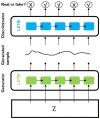Generative Adversarial Networks and Its Applications in Biomedical Informatics
- PMID: 32478029
- PMCID: PMC7235323
- DOI: 10.3389/fpubh.2020.00164
Generative Adversarial Networks and Its Applications in Biomedical Informatics
Abstract
The basic Generative Adversarial Networks (GAN) model is composed of the input vector, generator, and discriminator. Among them, the generator and discriminator are implicit function expressions, usually implemented by deep neural networks. GAN can learn the generative model of any data distribution through adversarial methods with excellent performance. It has been widely applied to different areas since it was proposed in 2014. In this review, we introduced the origin, specific working principle, and development history of GAN, various applications of GAN in digital image processing, Cycle-GAN, and its application in medical imaging analysis, as well as the latest applications of GAN in medical informatics and bioinformatics.
Keywords: Generative Adversarial Networks (GAN); biomedical applications; data augmentation; discriminator; generator; image conversion.
Copyright © 2020 Lan, You, Zhang, Fan, Zhao, Zeng, Chen and Zhou.
Figures





References
-
- Goodfellow IJ, Pouget-Abadie J, Mirza M, Bing X, Warde-Farley D, Ozair S, et al. Generative Adversarial Nets. In: International Conference on Neural Information Processing Systems Montréal, QC: (2014).
-
- Lin Y, Dai X, Li L, Wang X, Wang F. The new Frontier of AI research: generative adversarial networks. Acta Autom Sin. (2018) 44:775–92. 10.16383/j.aas.2018.y000002 - DOI
-
- Zhang Z, Zhou X, Zhao S, Zhang X. Semantic prior guided face inpainting. In: Zhang Z, Zhou X, Zhao S, Zhang X, editors. MMAsia '19. New York, NY: (2019).
-
- Hiasa Y, Otake Y, Takao M, Matsuoka T, Sato Y. Cross-modality image synthesis from unpaired data using CycleGAN: effects of gradient consistency loss and training data size. In: Goksel O, Oguz I, Gooya A, Burgos N, editors. Simulation and Synthesis in Medical Imaging - Third International Workshop, SASHIMI 2018, Held in Conjunction with MICCAI 2018, Proceedings. Granada: Springer verlag; (2018).
-
- Zhu JY, Park T, Isola P, Efros AA. Unpaired image-to-image translation using cycle-consistent adversarial networks. In: IEEE International Conference on Computer Vision. Venice: (2017).
Publication types
MeSH terms
LinkOut - more resources
Full Text Sources

